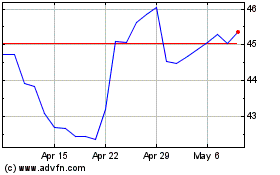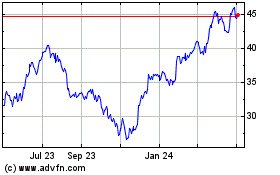By Paul Vigna
General Motors Co. suspended its dividend earlier this week,
part of a raft of moves to keep the company afloat in the midst of
the coronavirus pandemic. It is far from alone.
More companies have suspended or canceled their dividends so far
this year than in the previous 10 years combined, with companies
scrambling to preserve cash as the coronavirus pandemic saps
revenue.
Through Tuesday, 83 U.S. companies and public investment funds,
like real-estate investment trusts, have suspended or canceled
their dividends, the highest number in data going back to 2001,
according to S&P Global Market Intelligence. In the previous 10
years, 55 companies eliminated their dividends -- payouts that
companies make to shareholders as a reward for standing by
them.
"You would be hard-pressed to find a better time to cut
dividends and get forgiveness from investors," said David Lafferty,
chief market strategist at Natixis Investment Managers. "We're
going to see a massive pullback" among companies attempting to
hoard capital or bowing to political pressure.
GM and rival Ford Motor Co., which also suspended its dividend
last month, are attempting to ride out a multiweek shutdown of the
auto industry that has led to a collapse in vehicle demand. Other
companies such as Delta Air Lines Inc., Carnival Corp., Boeing Co.
and Macy's Inc. paused their dividends when global travel stalled
and retailers temporarily closed their doors to slow the spread of
the virus.
An additional 142 companies have reduced their payouts to
shareholders in 2020, on pace for the worst year since 2009 when
there were 316 such cuts. All the dividend actions so far add up to
savings of about $23 billion, according to S&P Dow Jones
Indices.
Overall, dividend payouts will fall about 10% this year, Bank of
America predicts, with the biggest cuts coming from companies in
the energy and consumer discretionary sectors. Last year set a
record for dividend payouts at $491 billion.
In the short term, investors haven't punished companies for
suspending their dividends. Shares of GM, Boeing, Carnival and
Delta all rose in the trading session after they announced the
moves -- a sign that investors are ignoring the usual dour
implications of such cuts at a time when companies across
industries need to conserve cash.
"If the dividend suspension makes sense, I'd be OK with it,"
said Don Kilbride, senior managing director at Wellington
Management and portfolio manager of the Vanguard Dividend Growth
Fund. "A period of weaker dividend growth given the environment
should not bother you."
The recent stock-market rout has made dividends an even more
crucial source of income for investors. With the market in turmoil
and central banks pushing down rates on government debt, the yields
on dividend-paying stocks and funds have become more attractive.
The S&P 500 is down 11.4% this year.
The collapse in prices has translated into a surge in yields --
the ratio of the dividend payout divided by stock price. The
S&P 500's dividend yield has risen to 2.06% from 1.73% at the
start of the year. It climbed as high as 2.56% on March 23 when
stocks hit their recent lows, marking the highest level since
August 2009.
In comparison, the yield on the benchmark 10-year U.S. Treasury
note is 0.61%. The spread between the two yields on March 23 was
the widest on record in data going back to 1999, according to Dow
Jones Market Data.
"Dividends versus fixed alternatives look more attractive," Mr.
Lafferty said. But that on its own doesn't offset the risk that a
company will cut or suspend its payout, he cautioned.
The surge in yields has been even more dramatic for some
beaten-down stocks. Exxon Mobil Corp. shares, for instance, have
fallen 36% year-to-date, pushing the yield up to 7.7% from 4.99% at
the start of the year. Chevron Corp. is down 25% this year; that
has pushed its yield up to 5.7% from 3.95%.
Rising yields are good for investors, but the subtext is
critical. If the yield is rising because of a falling stock price
or problems at the company, it may not be sustainable. Both Exxon
and Chevron have outlined plans to slow other spending during the
pandemic, partly to preserve their ability to maintain their
dividends.
Almost as important as the income stream itself, dividends are a
way for companies to send a signal to investors, which is a big
reason why they are loath to cut them, said Simeon Hyman, the chief
strategist at asset manager ProShares, which sells dozens of
exchange-traded funds.
"If you increase your dividend, you are pounding the table that
you have confidence," he said, mentioning recent increases from
both Johnson & Johnson and Procter & Gamble Co. "If you're
cutting, you are capitulating. You are saying times are going to be
bad for a little while."
All four companies are known as dividend aristocrats, firms that
have increased their shareholder payouts every year for at least 25
years. S&P has an index that tracks 64 companies in its
benchmark index that meet the criteria.
There are a number of ETFs that, in turn, track the dividend
aristocrats. Some companies are hesitant to cut their payouts
because they don't want to be removed from such funds.
One of the most high-profile is the ProShares S&P 500
Dividend Aristocrats ETF. The ETF is down 15% on the year,
underperforming the S&P 500. But the drop has nudged up the
fund's yield to 2.4% from 2.3% at the end of 2019.
"Some of these funds, in fact, could shield investors from a
collapse in dividends," Mr. Hyman said.
That isn't only because investors are buying long-term, quality
companies, he said, they are also shielded from the direct impact
of dividend cuts.
If a dividend aristocrat cuts its payout, it is dropped from
S&P's index and subsequently the ETFs that track it. But at
least for the ProShares fund, the shares are sold and the proceeds
are reinvested in the remaining companies. The result could be that
the fund's yield actually goes up, not down, he said.
Write to Paul Vigna at paul.vigna@wsj.com
(END) Dow Jones Newswires
April 28, 2020 17:22 ET (21:22 GMT)
Copyright (c) 2020 Dow Jones & Company, Inc.
General Motors (NYSE:GM)
Historical Stock Chart
From Mar 2024 to Apr 2024

General Motors (NYSE:GM)
Historical Stock Chart
From Apr 2023 to Apr 2024
